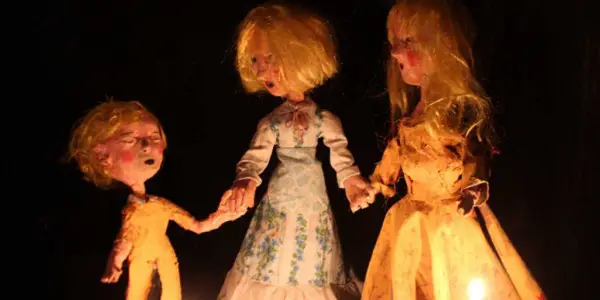It isn’t very often nowadays that you can say you’ve just watched a movie unlike anything you’ve ever seen before, yet while watching The Wolf House, a surreal stop-motion animated feature from Chilean filmmakers Cristóbal León and Joaquín Cociña, I was awestruck by the film’s incredible audacity and originality. The Wolf House is inspired by the real-life case of Colonia Dignidad, an isolated, cult-like colony established by German emigrants in post-World War II Chile that was responsible for abuse and torture during the Pinochet dictatorship. Yet one does not have to be familiar with the film’s inspiration to fall under the spell of its dark, twisted magic.
Who’s Afraid of the Big Bad Wolf?
The film begins with a message from a leader of an isolated sect in Chile, who informs us that this animated fairy tale is being presented as proof that the colony is not the house of horrors of which it has been painted by outsiders. In other words, it is a propaganda film designed to eliminate any doubts from the minds of the sect’s followers and convince them of the perils that await them if they try to escape. This clever bookending device adds an extra layer of subliminal horror to The Wolf House, forcing us to keep these shadowy intentions in the back of our minds as we’re yanked down the rabbit hole into a weird world, unlike anything we’ve seen before.

The Wolf House tells the story of Maria, a young woman who is demonized by the sect’s leaders for not working hard enough; she’d rather play with the animals kept by the colony. When Maria’s lackadaisical behavior leads three of the colony’s pigs to escape, Maria runs away to avoid punishment. Fleeing into the woods with a hungry wolf on her tail, Maria takes refuge in an abandoned house where she finds two of the three escaped pigs. Maria dubs them Ana and Pedro and, with her imagination working in overdrive, transforms them into human children. Yet Maria’s almost idyllic, albeit incredibly odd, attempts at playing house with her adopted “children” take a turn for the worse when the food in the house runs out.
Maria in Wonderland
The closest comparison one can make with The Wolf House is to a tale by the Brothers Grimm filtered through the gaze of David Lynch, but even that description, while apt, does a disservice to the visual inventiveness of the film. Produced over several years as a public art installation in galleries around the world, The Wolf House uses stop-motion animation to render the world inside the titular house as an ever-evolving nightmare. That the film appears to be a single sequence shot when it was pieced together in this way only adds to its impressiveness.
As one moves from room to room throughout the house, the rooms themselves evolve, walls crumbling and expanding and changing in hue to convey the mood of a scene. Maria herself does the same; in some scenes, she sprouts limbs that grow and twist and evolve to serve her purpose, while in others, she becomes part of the house herself, a two-dimensional drawing who seems to be trapped within the walls.
In one of the film’s more terrifyingly surreal sequences, we see the pigs physically change shape and become the human children that Maria’s mind wants them to be, their papier-mache snouts shrinking as waves of golden doll hair sprout from their heads. The variety of materials used to render the characters and their home — scraps of fabric, splatters of paint, pieces of plastic — gives the impression that one has entered a world constructed entirely out of items discarded as trash that, in Maria’s mind, take on a new life.
While the visuals are the main star of The Wolf House, the film’s spooky soundscape goes a long way towards fully rounding out the world of the film. There are only two voice actors involved in The Wolf House: Amalia Kassai as Maria, Ana and Pedro and Rainer Krause as the sect leader and the wolf. Their voices, switching seamlessly between German and Spanish, are warped and layered and echoed off each other, adding to the claustrophobic feeling one gets the longer one spends inside the house.
It is worth noting that The Wolf House is only 75 minutes long, which is the perfect length for a film packed with so much visual and aural stimulation. Throw in a perfectly curated collection of sound effects recorded at levels that just subtly exaggerate every tone, and the result is a film that I cannot imagine not being totally immersed in.
Conclusion
While some might initially balk at the film’s unabashed freakiness, the sheer creativity that fills every frame of The Wolf House should be seen and celebrated by everyone.
What do you think? Are you a fan of stop-motion animation? Share your thoughts in the comments below.
The Wolf House will be released for streaming via virtual screening rooms that benefit your local theaters on May 15, 2020. Check the Kimstim Films website for additional release dates.
Does content like this matter to you?
Become a Member and support film journalism. Unlock access to all of Film Inquiry`s great articles. Join a community of like-minded readers who are passionate about cinema - get access to our private members Network, give back to independent filmmakers, and more.